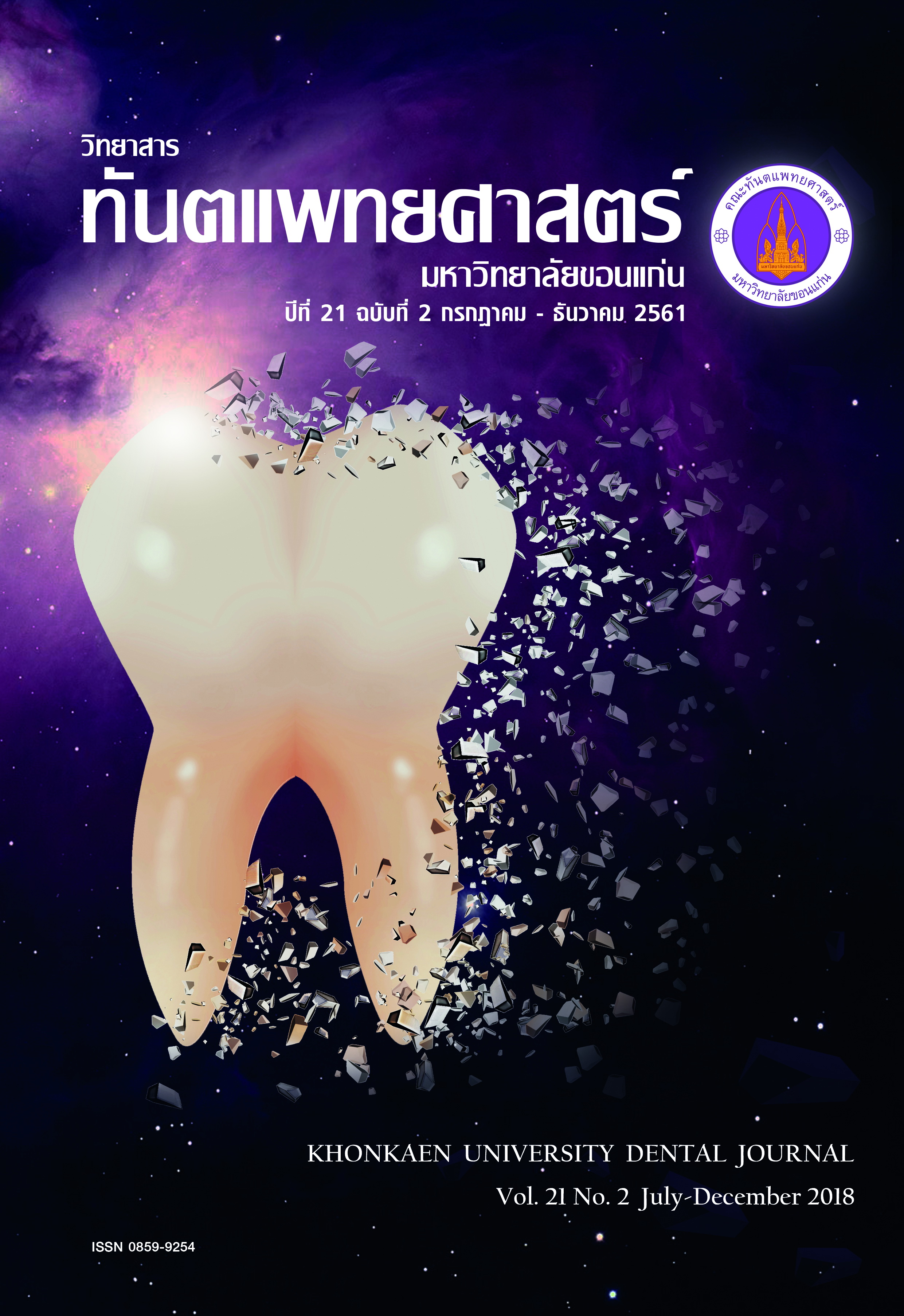Effectiveness of Oral Health Education between Dentist and Trained School Health Teacher
Main Article Content
Abstract
One of the problems in school health education program is the limitation of dental public health officers. Furthermore, school health teachers could not deliver the good knowledge and teach effectively to the students. Therefore, the aim of this study was to compare the effectiveness of dentist and trained school health teacher in delivering oral health education to the students. Fifth- and sixth- grade elementary school students were divided into 3 groups: dentist group (n=48), trained teacher group (n=48), and control group which did not receive any oral health education (OHE) (n=46). The evaluation using oral hygiene knowledge test and plaque examination was performed before and after OHE program and analyzed by Paired sample t-test. The difference between groups was analyzed by one-way ANOVA. In knowledge test, both dentist and trained teacher groups had an increased oral health knowledge scores at immediate -and 3 months -post program when compared with baseline (p < 0.05). There was no statistically significant difference in both OHE groups (p > 0.05). Moreover, it was shown that plaque scores at 3 months -post program were decreased significantly in both OHE groups when compared with baseline (p < 0.05). There was no statistically significant difference of plaque scores in both groups (p > 0.05). This study concluded that the effectiveness of dentist and trained teacher in delivering oral health education to the students was not significantly different.
Article Details
บทความ ข้อมูล เนื้อหา รูปภาพ ฯลฯ ที่ได้รับการลงตีพิมพ์ในวิทยาสารทันตแพทยศาสตร์ มหาวิทยาลัยขอนแก่นถือเป็นลิขสิทธิ์เฉพาะของคณะทันตแพทยศาสตร์ มหาวิทยาลัยขอนแก่น หากบุคคลหรือหน่วยงานใดต้องการนำทั้งหมดหรือส่วนหนึ่งส่วนใดไปเผยแพร่ต่อหรือเพื่อกระทำการใด ๆ จะต้องได้รับอนุญาตเป็นลายลักษณ์อักษร จากคณะทันตแพทยศาสตร์ มหาวิทยาลัยขอนแก่นก่อนเท่านั้น
References
2. Stahl J, Zandora AF. Rationale and protocol for the treatment of non-cavitated smooth surface carious lesions. Gen Dent 2007;55(2):105-11
3. Steinberg S. A paradigm shift in the treatment of caries. Gen Dent 2002;50(4):333-8.
4. Dental Health Division, Ministry of Public Health. 3rd ed. Bangkok: Office of Silpakorn University Academic services; 2017. 138-9.
5. Nowak AR, Mabry TR. Prevention of dental disease. In: Casamassimo PS, Fields HW, McTigue DJ and Nowak AJ. Pediatric Dentistry infancy through adolescence. 5th ed. St Louis:Elsevier;2013.460-66.
6. Mota A, Oswal KC, Sajnani DA, Sajnani AK. Oral health knowledge, attitude, approaches of pre-primary and primary schooll teachers in Mumbai, India. Scientifica (Cairo) 2016 [cited 2017 Dec 28]; Article ID 5967427, [8 pages]. Available from: https://dx.doi.org/10.1155 /2016/ 5967427.
7. Dental2.anamai.moph.go.th [homepage on the Internet]. Thailand: Department of health:ministry of public health.;c2016 [updated 2016 Aug 15; cited 2018 Apr 27]. Available from: https://dental2.anamai.moph.go.th/ewtad¬min/ewt/dental/download_detail.php?dl_id=78.
8. Arunprapun S, Prasertsom P, Kaewkuntee D. Jirapongsa W, Rattanarungsima K. Situation of health promotion in primary school. Thai Dental Public Health Journal 2007; 12(1):50-9.
9. Health Intervention and Technology Assessment Program. The Evaluation of school health services in primary school [Monograph on the internet] Nontaburi: National Health Security Office [cited 2017 Dec 28]. Available from https:// www.hitap.net/documents/167154.
10. Green JC, Vermillion JR. The simplified oral hygiene index. J Am Dent Assoc 1964;68(1):7-13.
11. Boneau CA. Hermann Ebbinghaus: On the road to progress or down the garden path?. In: Kimble GA and Wertheimer M (eds). Portraits of Pioneers in Psychology Volume III. 1st ed. New Jersy:Lawrence Erlbaum;1998:51-64.
12. Goel P, Sehgal M, Mittal R. Evaluating the effectiveness of school-based dental health education program among children of different socioeconomic groups. Indian Soc Pedod Prev Dent 2005;23(3):131-3.
13. Query S, Stokesbary C. Understanding and working with youth [Monograph on the internet] Fargo: North Dakato State University; 2010 [cited 2017 Dec 28]. Available from: https://www.ag.ndsu.edu/pubs/yf/youthdev/yd1470.pdf.
14. Harvey K, Horton L. Bloom’s Human Characteristic and School Learning. The Phi Delta Kappen. 1977;59(3):1 89-93.
15. Butresri K. Dental public health surveillance practices of health teachers and public health officers in primary schools, Kogsamrong, Lopburi: [dissertation]. Bangkok:Univ of Mahidol;1999.
16. Nuerklong A. The relationship between dental health program operation and problems of oral health education of health teachers in primary schools, Klongtom, Krabi: [dissertation]. Bangkok:Univ of Mahidol;2000.
17. Nyandindi U, Milen A, Palin-Palokas T, Robison V. Impact of oral health education on primary school children before and after teachers’ training in Tanzania. Health Promot Int 1996;11(3):193-201.
18. apps.who.int [homepage on the Internet]. Geneva: World Health Organization; c2017 [cited 2018 Apr 27]. Available from: https://apps.who.int/iris/bitstream/handle/10665/ 61425/WHO_UNESCO_UNICEF_92.2.pdf? sequence=1&is¬Allowed=y.
19. Frazier PJ. School-based instruction for improving oral health: closing the knowledge gap. Int Dent J 1980;30(3):257-68.
20. Hermien N, Ani S, Alfani C. Comparing an Interactive Software and Flipchart Media for Dental Health Knowledge Among Elementary School Students in Semarang. Adv Sci Lett 2017;23(4):3299-301.


